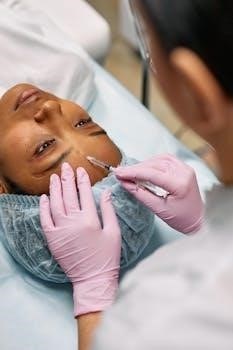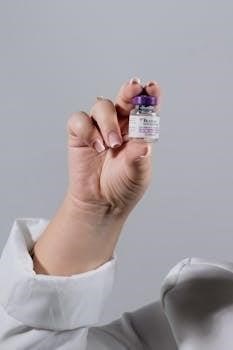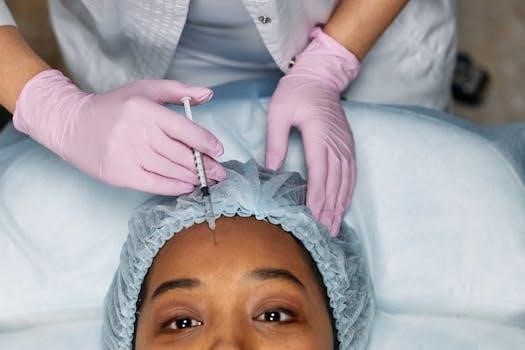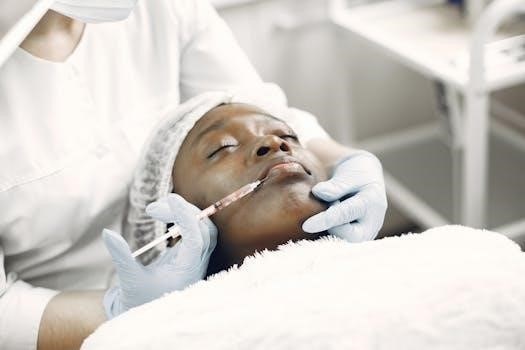Understanding the precise locations for Botox injections is crucial for effective treatment. A Botox injection site diagram serves as a vital guide‚ illustrating key areas on the face and neck where injections are most commonly administered‚ such as the forehead‚ glabella‚ and crow’s feet‚ ensuring optimal results.
Understanding the Importance of a Botox Injection Site Diagram
A Botox injection site diagram is an essential tool for both practitioners and patients. This visual guide clearly outlines the specific locations on the face and neck where Botox injections are most effective. The diagram helps to ensure precise application‚ targeting the correct muscles to achieve the desired outcome. This is particularly important because injecting Botox into the wrong place could lead to unwanted side effects or ineffective results. The diagram helps in visualizing the treatment plan‚ promoting a shared understanding of the targeted areas‚ and aligning expectations. It also shows muscle mass and proximity to the neuromuscular junction‚ which helps determine the dosage required for each site. A well-designed diagram is also crucial for avoiding critical structures‚ thus enhancing patient safety and satisfaction. The use of the diagram also promotes consistent results and reduces the chances of errors in the injection process. By providing a clear visual reference‚ the diagram facilitates better communication between the practitioner and the patient‚ making the treatment more comfortable and effective.

Common Facial Botox Injection Sites
Botox injections are commonly used to address facial wrinkles. Key areas include the forehead‚ glabella (frown lines)‚ and crow’s feet. These sites are targeted to relax muscles and reduce the appearance of wrinkles‚ resulting in a smoother look.
Forehead Lines

Forehead lines‚ also known as horizontal forehead wrinkles‚ are a common concern that Botox injections can effectively address. These lines are primarily caused by the contraction of the frontalis muscle‚ which is responsible for raising the eyebrows. Botox works by temporarily relaxing this muscle‚ smoothing out the wrinkles and creating a more youthful appearance. The specific injection sites for forehead lines vary based on individual muscle patterns and strength. Common injection points include several locations across the forehead‚ carefully placed to target the frontalis muscle’s activity while avoiding unwanted effects like eyebrow drooping. A detailed understanding of the anatomy and muscle patterns of the forehead area is crucial for a successful Botox treatment. The goal is to reduce the visibility of horizontal lines without compromising natural facial expressions. This often requires a personalized approach‚ assessing each patient’s unique needs and muscle activity. The use of a Botox injection site diagram can help both practitioners and patients understand the targeted areas for achieving the desired smoothing effect.
Glabellar Lines (Frown Lines)
Glabellar lines‚ commonly known as frown lines or the “elevens‚” are vertical wrinkles that appear between the eyebrows. These lines result from the repeated contraction of the procerus and corrugator muscles when we frown or concentrate. Botox injections are highly effective in treating these lines by temporarily paralyzing the muscles responsible for their formation‚ leading to a smoother‚ more relaxed appearance. Injection points are typically located directly in and around the area between the eyebrows‚ specifically targeting the corrugator and procerus muscles. The precise location and number of injections can vary based on individual anatomy and the severity of the lines. A thorough understanding of the facial muscles is essential for safe and effective treatment. It’s crucial to avoid over-treatment‚ which can lead to an unnatural or “frozen” look. The use of a Botox injection site diagram is extremely helpful for both the practitioner and the patient to visualize the treatment area and understand the placement of injections. The goal is to soften the appearance of frown lines while maintaining a natural range of facial expressions.
Crow’s Feet
Crow’s feet are the fine lines that radiate from the outer corners of the eyes‚ becoming more prominent when smiling or squinting. These wrinkles result from the repeated contraction of the orbicularis oculi muscle surrounding the eye. Botox injections in this area target this muscle‚ temporarily relaxing it and reducing the appearance of these lines. The injection sites for treating crow’s feet are typically located along the outer edge of the eye socket‚ avoiding the area too close to the eye itself. Proper placement and dosage are crucial to prevent complications such as eyelid droop. The number of injection points and the amount of Botox used can vary depending on the individual’s muscle strength and the extent of the wrinkles. A thorough understanding of the anatomy of the periocular area is essential for practitioners. A Botox injection site diagram helps visualize the targeted area‚ making the treatment safe and effective. The goal of Botox treatment for crow’s feet is to soften the lines while maintaining natural facial expressions. It’s important to have a consultation with a qualified professional to determine the best approach for your specific needs.
Bunny Lines
Bunny lines‚ also known as nasalis lines‚ are the small wrinkles that appear on the sides of the nose when a person scrunches up their face‚ often while laughing or smiling. These lines are caused by the contraction of the nasalis muscle‚ which is located on either side of the nose. Botox injections for bunny lines aim to relax this muscle‚ reducing the appearance of these wrinkles and creating a smoother look. The injection sites are usually located on the lateral sides of the nose‚ along the lines themselves. The number of injection points and the amount of Botox required will vary from person to person‚ depending on the extent of the wrinkles and the strength of the nasalis muscle. Precise injection placement is essential to avoid unintended effects on nearby muscles. A Botox injection site diagram can help guide practitioners in identifying the correct areas for treatment. It’s important that the treatment is administered by a skilled professional who understands the facial anatomy and can tailor the injections to achieve the best results. These injections can significantly improve the appearance of bunny lines‚ contributing to a more youthful and refreshed look.

Other Botox Injection Areas
Beyond the common facial areas‚ Botox is also used to treat other specific concerns; These include the chin dimple‚ where injections relax the mentalis muscle. Additionally‚ neck bands and masseter muscles are targeted for cosmetic and therapeutic purposes.
Chin Dimple
The chin dimple‚ often caused by an overactive mentalis muscle‚ can be effectively addressed with Botox injections. This muscle‚ located in the chin area‚ contributes to the formation of a dimpled or pebbled appearance when contracted. Botox works by relaxing this muscle‚ thereby smoothing out the chin’s surface and reducing the visibility of the dimple. The injection process typically involves administering a small amount of Botox directly into the mentalis muscle. This procedure aims to create a more even and youthful contour to the chin. The treatment is relatively quick‚ and the results become noticeable within a few days‚ generally lasting for several months. Botox injections for chin dimples are a popular option for those seeking a non-surgical method to refine their facial features. It is crucial that a qualified professional administers these injections to ensure the best outcome and minimize any potential side effects. The treatment is considered a safe and effective way to achieve a smoother chin appearance.

Neck Bands
Neck bands‚ also known as platysmal bands‚ are vertical lines or cords that appear on the neck due to the contraction of the platysma muscle. Botox injections can effectively reduce the prominence of these bands by relaxing the underlying muscle. The procedure involves carefully injecting small amounts of Botox into specific points along the platysma muscle. This targeted approach helps to smooth the neck’s appearance and minimize the visibility of the bands. The number of injection sites and the amount of Botox used will vary depending on the individual’s anatomy and the severity of the neck bands. The treatment is generally quick and requires minimal downtime. Results typically become noticeable within a few days‚ with the full effect visible after about two weeks. The effects usually last for three to four months‚ after which maintenance treatments may be necessary. It’s important to have this procedure performed by a qualified professional for optimal results and safety.
Masseter Muscles
The masseter muscles‚ located on the sides of the jaw‚ are responsible for chewing. When these muscles become overdeveloped‚ they can lead to a square jawline and sometimes teeth grinding or clenching (bruxism). Botox injections into the masseter muscles can help relax them‚ leading to a softer‚ more V-shaped jawline and a reduction in teeth grinding; The procedure involves injecting Botox into specific points on the masseter muscle‚ which gradually weakens the muscle over time. The treatment is quick and relatively painless. It typically takes a few days to begin noticing the effects‚ with full results visible within two weeks. The results usually last for three to four months‚ requiring maintenance treatments to sustain the desired effect. This treatment is not only cosmetic‚ but it can also provide relief for those who experience jaw pain or discomfort from teeth grinding; The number of injection sites and the dosage will depend on the individual’s muscle mass and the desired outcome. Consulting with a qualified professional is essential for safe and effective treatment.
